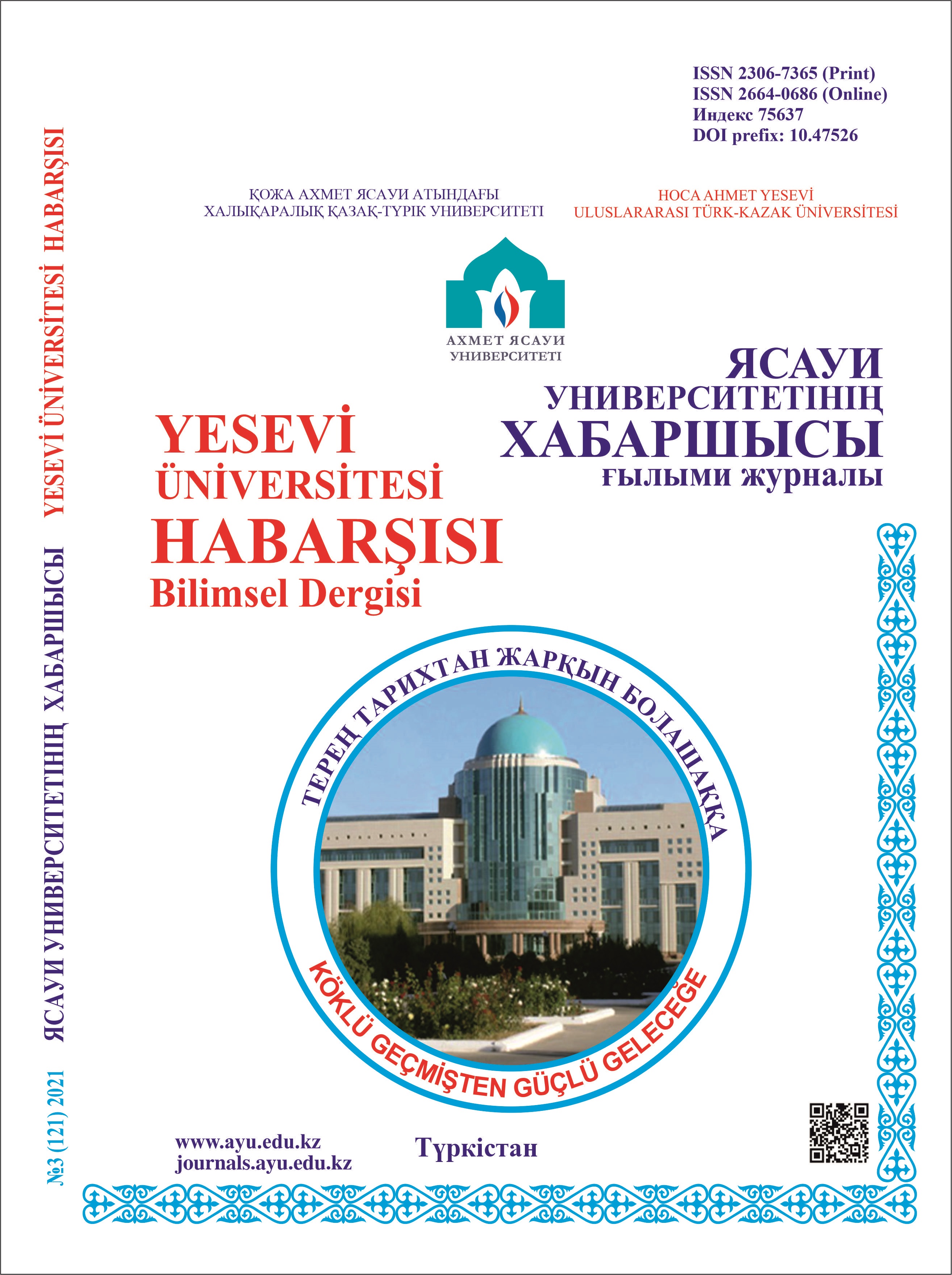STEAM CLIL TEKNOLOJİSİNİ UZAKTAN EĞİTİM ORTAMINDA KULLANMANIN ETKİNLİĞİ
158 75
Anahtar Kelimeler:
STEAM CLİL teknolojisi, uzaktan eğitim, dijital eğitim kaynakları, mekanik departmanı, iki dilli eğitim.Özet
Bu makale, STEAM CLIL modelinin etkin bir şekilde uygulanması, uzaktan eğitim yoluyla dil becerilerinin geliştirilmesi ve modern dünyaya uyarlanması yoluyla öğrencilerin bilimsel kavramları derinlemesine inceleme olanaklarını incelemektedir. STEAM CLIL teknolojisinin etkinliğini etkileyen ana faktörleri incelemek, kaliteli eğitim sağlamada ve öğrencileri bilgi toplumunun zorluklarına hazırlamada önemli bir adımdır. Bu nedenle, STEAM unsurlarını (bilim, teknoloji, mühendislik, matematik) CLIL (İçerik ve Dil Entegre Öğrenme) öğrenme yöntemiyle birleştiren öğrenme metodolojisinin etkinliği kapsamlı bir şekilde analiz edilmektedir. Uzaktan eğitimde STEAM CLIL eğitim modellerinin kullanılmasının öğrencilerin öğrenme başarıları, dil becerileri, yaratıcılığı ve problemli düşüncesi üzerindeki etkisi incelenmiştir. Bilimsel çalışmaların sistematik bir analizi yapıldı, STEAM CLIL'İN unsurları ve dijital eğitim kaynaklarının olanakları analiz edildi. Pedagojik bir deney düzenlendi, elde edilen verilerin istatistiksel ve matematiksel analizi yapıldı. Araştırma sonucunda dijital eğitim kaynakları, STEAM unsurları, CLIL tabanlı bir dizi görev geliştirilmiş ve öğrenme sürecine dahil edilmiştir. Çalışmanın sonuçlarının kullanılması, STEAM CLIL modelinin değerlendirilmesinin öğrencilerin eğitim deneyimlerini zenginleştirme konusunda önemli bir potansiyele sahip olduğunu göstermiştir. Bu makalede sunulan metodik yaklaşımlar, eğitim deneyimini geliştirmeyi amaçlayan kanıta dayalı sonuçlar sunarak uzaktan eğitimde STEAM CLIL modelinin etkin kullanımına katkıda bulunmaktadır.
Referanslar
REFERENCES
Şenel M. CLIL and digital natives // International Journal of Languages’ Education. – 2015. – Vol. 1 (UDES 2015). https://doi.org/10.18298/ijlet.461
Capone R., Del Sorbo M.R., Fiore O. A flipped experience in physics education using CLIL methodology // Eurasia Journal of Mathematics, Science and Technology Education. – 2017. – Vol. 13, №10. – P. 6579–6582. https://doi.org/10.12973/ejmste/77044
Kovrizhnykh D.V. Analysis of Teaching Physics Through Interim Language as Preconditions for Humanitarian Training of Science Teachers for Differentiated Approach in CLIL // Journal of Higher Education Theory and Practice. – 2022. – Vol. 22, №8. – P. 19–32. https://doi.org/10.33423/jhetp.v22i8.5312
Nikula T. Hands-on tasks in CLIL science classrooms as sites for subject-specific language use and learning // System. – 2015. – Vol. 54. – P. 14–27. https://doi.org/10.1016/j.system.2015.04.003 5. Rosi F. Content-Specific Learning in CLIL: The case of physics teaching in Italy // EL.LE. – 2018. – №1. – P. 27–49. https://doi.org/10.30687/elle/2280-6792/2018/01/002
Zhetpisbayeva B., Syrymbetova L., Chizhevskaya Y. Interlingual Interference in CLIL Learning // World Journal of English Language. – 2023. – Vol. 13, №8. – P. 100–107. https://doi.org/10.5430/wjel.v13n8p100
Bin Amiruddin M.Z., Magfiroh D.R., Savitri I., Binti Rahman S.M.I. Analysis of The Application of The STEAM Approach to Learning In Indonesia: Contributions to Physics Education // International Journal of Current Educational Research. – 2022. – Vol. 1, №1. – P. 1–17. https://doi.org/10.53621/ijocer.v1i1.139 8. Bai Y., Peng D., Yang J. Design of virtual physics laboratory based on STEAM education // International Conference on Education, Economics and Information Management (ICEEIM 2019). – Atlantis Press, 2020. – P. 18–21. https://doi.org/10.2991/assehr.k.200401.006
Witdiya T., Supriadi G., Supriatin A., Annovasho J. The Effect of STEAM Learning on Improving Each Indicator of Students’ Creative Thinking in Physics Learning // Jurnal Ilmiah Pendidikan Fisika. – 2023. – Vol. 7, №1. – P. 42. https://doi.org/10.20527/jipf.v7i1.7158
Anisimova T.I., Sabirova F.M., Shatunova O.V. Formation of design and research competencies in future teachers in the framework of STEAM education // International Journal of Emerging Technologies in Learning. – 2020. – Vol. 15, №2. – P. 204–217. https://doi.org/10.3991/ijet.v15i02.11537
Bassachs M., Cañabate D., Nogué L., Serra T., Bubnys R., Colomer J. Fostering critical reflection in primary education through STEAM approaches // Education Sciences. – 2020. – Vol. 10, №12. – P. 1–14. https://doi.org/10.3390/educsci10120384 12. Usembayeva I.B., Ramankulov Sh.Zh., Bitibaeva J.M., Moldabekova M.S., Polatuky S. The use of STEAM technology for the development of applied physics teaching // Bulletin of Abai KazNPU. Series Physical and Mathematical Sciences. – 2023. – №4(80). – Б. 277–284. https://doi.org/10.51889/6602.2022.72.66.032 [in Kazakh]
Ramankulov Sh., Choruh А., Polatuly С. STEAM technology as a tool for developing creativity of students: on the example of a school physics course // Iasaui Universitetіnіn habarshysy. – 2022. – №4(126). – P. 200–211. https://doi.org/10.47526/2022-4/2664-0686.17
Shatunova O., Anisimova T., Sabirova F., Kalimullina O. STEAM as an innovative educational technology // Journal of Social Studies Education Research. – 2019. – Vol. 10, № 2. – P. 131–144.
Martyniuk O.O., Martyniuk O.S., Pankevych S., Muzyka I. Educational direction of STEM in the system of realization of blended teaching of physics // Educational Technology Quarterly. – 2021. – № 3. – P. 347–359. https://doi.org/10.55056/etq.39 16. Sulaiman F., Rosales J.J., Kyung L.J. The effectiveness of the integrated STEM-PBL physics module on students’ interest, sensemaking and effort // Journal of Baltic Science Education. – 2023. – Vol. 22, №1. – P. 113–129. https://doi.org/10.33225/jbse/23.22.113
Sagala R., Umam R., Thahir A., Saregar A., Wardani I. The effectiveness of STEM-based on gender differences: the impact of physics concept understanding // European Journal of Educational Research. – 2019. – Vol. 8, №3. – P. 753–761. https://doi.org/10.12973/eu-jer.8.3.753
Yusuf I., Widyaningsih S. W. HOTS profile of physics education students in STEM-based classes using PhET media // Journal of Physics: Conference Series. – 2019. – Vol. 1157. – №3. – С. 032021. https://doi.org/10.1088/1742-6596/1157/3/032021
Asrizal A., Mardian V., Novitra F., Festiyed F. Physics electronic teaching material-integrated STEM education to promote 21st-century skills // Cypriot Journal of Educational Sciences. – 2022. – Vol. 17, №8. – P. 2899–2914. https://doi.org/10.18844/cjes.v17i8.7357
Yunzal A.N. Jr., Casinillo L.F. Effect of Physics Education Technology (PhET) Simulations: Evidence from STEM Students’ Performance // Journal of Education Research and Evaluation. – 2020. – Vol. 4, №3. – P. 221–226. https://doi.org/10.23887/jere.v4i3.27450

